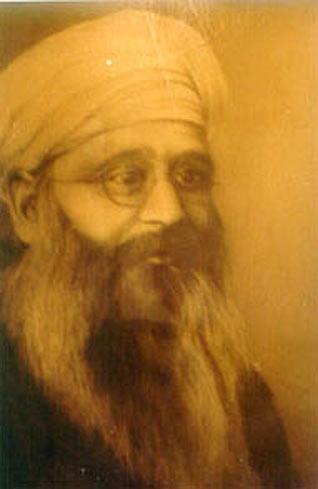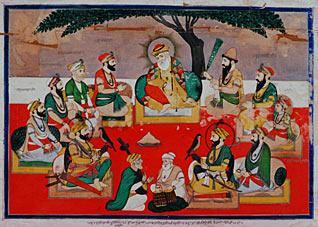Columnists
The Spirit Born People
Book Review by LAURIE BOLGER
THE SPIRIT BORN PEOPLE
by Puran Singh
Reprinted by Singh Brothers, Amritsar, 2002
168 pages Price: Rs. 80.00
My discovery of the man popularly known as Prof Puran Singh through this book, widely considered to be his crowning literary achievement, was a mind-stretching, soul-elevating experience. A true "spark-kindler", the magic of his message made every page of this work radiate the incandescent glow of Sikh spirituality.
"The title ‘Sikh' - ‘The Disciple' - was first given to us by Guru Nanak. We were mere corpses, he poured life into us. He did knit us with the Universe and he wove the design of the Infinite into the texture of our soul ... Our history is of the soul, all its events are of the soul. All truth for us is personal. We have not to prove it, we have to stand witness to it in our soul. By the title ‘Sikh', he linked us with Himself forever."
Right from these lines, at the start of the first chapter, it is immediately obvious that The Spirit Born People is far from being a conventional scholarly treatise on Sikhi. Rather, it is an elucidation of the immense spiritual enlightenment of its author, Puran Singh, written in an intensely mystical and lyrical style.
The author's profound sense of connection and commitment to his beloved faith is unmistakable and omnipresent. This book's complete lack of stuffy, catechistic preaching makes Sikhi come alive in all its vibrant timelessness and universality. Just as planets circle the sun, so "the spirit born people" are portrayed as revolving around the Guru, whose Word, according to Puran Singh, is the "companion of eternity". He credits the preceptors of the Word, the Ten Sikh Gurus, for reconstructing the world according to "the law of love". Through the Gurus' teachings -- from Guru Nanak, who "is the Name we sing as the birds sing the joy of the new dawn", to Guru Gobind Singh, who "gathered the waves of the Ocean of Consciousness as the mother gathers the hair of the child" - we can learn how to realize surta, or "soul-consciousness", the thread which keeps us linked to the spiritual realms of which the Gurus speak so wondrously.
It is in describing the exquisite gifts of Guru Gobind Singh, creator of the "Brotherhood of the Tress-Knot" ("those whose presence sheds the Nectar of Peace all around, emitting radiations of universal goodwill and love"), that I found Puran Singh's stirring lyricism to be at its most intoxicatingly potent. This portion of the book contains many often-quoted lines regarding the inestimable value of the kakaars, or Sikh articles of faith. The kirpan is transformed into the visible sign of an intensely sensitive soul: a sword-like, unconquerable mind, honed through love of the Guru. The crown of flowing kesh-tresses contains the life spark of the Guru and the fragrance of His touch. The wrist that bears the kara is evidence of being captivated by the Guru's infinite love.
However true it may be that for many Sikhs, death would be preferable to parting from these sublime gifts, Puran Singh cautions that they are never to be imposed by force or pressure on those who do not wish to receive them. Furthermore, he acknowledges that what is of paramount importance is "the expression of the Sikh soul through their medium" - if this is lacking, they become mere objects of meaningless superstition.
For some readers, allusions to the "Brotherhood of the Tress-Knot", being "molded in the image of Guru Gobind Singh", and realizing the "secrets of spiritual manhood", will undoubtedly convey a sense of exclusionary androcentrism totally out of sync with the ideals of gender-equality that lie at Sikhi's very core.
I would feel remiss if I did not stress my belief that careful, thoughtful digestion of these concepts is key to the perception of what, in my opinion, is Puran Singh's true message. While explanations are sometimes overtly given ("The Brothers of the Tress-Knot of Guru Gobind Singh are a Sangha in which women take free and equal membership"), more often than not, readers must themselves assume the burden of interpreting the masculine terms used for these ideas in the context of the time - 1928 - in which they were written. Granted, for some, this will be far from a simple task. Be that as it may, I think the effort is definitely one that will bear a cornucopia of satisfying fruit.
It would be all too easy for some of us to relegate The Spirit Born People to the murky morass of books waded through decades ago, and for others, who have not yet made its acquaintance, to feel that it is a work incapable of speaking to today's reader. Falling prey to either of these attitudes would be, in my opinion, most unfortunate.
Like the young, vibrant faith it so lovingly and powerfully portrays, this book is of timeless relevance and validity. Whether a re-introduction or a first-time encounter, delving into its treasure-filled depths does not disappoint. Its passionate lyricism elates the heart; its sparks of wisdom ignite the mind.
Bottom photo on this page: The Ten Gurus, with attendants. Miniature, water colour on paper, by Bhai Puran Singh (not to be confused with Prof Puran Singh). Punjab Plains, 1882.
Photo on Home Page: Courtesy - Dinodia.
Conversation about this article
1: Gurpreet Singh Sumra (Brampton,Canada), February 21, 2007, 10:26 AM.
A very good review by Laurie. Prof. Puran Singh was indeed a great Sikh visionary and scholar of the 20th century. Roughly around the same time, there was another Sikh author by the name of Gurbaksh Singh "preetladi" who invited the wrath of some people over one of his best pieces in which he referred to Guru Gobind Singh as "param manukh" - the Prime Human. I wish that article and others could be made available in English.
2: Inder Singh (California, USA), March 20, 2007, 9:16 PM.
I believe the Gurbaksh Singh (Preetlari) Mr Sumra refers to, was widely known to be a hard-core communist and an atheist. Concern over his writings then centred around the question: how could he write about Guru Sahib if he was anti-religion and a non-believer? I have read Gurbaksh Singh's writings. I too was once also swayed for a short time as a non-believer. Thank God I came to my senses, and returned to my religion.
This essay about Prof Puran Singh by Laurie is superb. He was indeed a gem of our community.
3: Gaganpreet Singh (Bangalore, India), March 28, 2007, 1:23 AM.
Guru Nanak himself says that some call him "bhootna" (demon) and some call him "betala" (evil spirit). But we don't go by what people called him, do we? Instead, if we want to meet him, we go to Guru Granth Sahib and experience him directly. Similarly, rather than rejecting people on reputation alone, let's benefit from reading what they have given to us. (i.e. their works). People like Prof. Puran Singh and Gurbaksh Singh (Preetlari) are made forever immortal by their writings ... they are imbibed with the fragrance of Gurbani.
4: Manmohanpal Singh (Srinagar, Kashmir), December 11, 2010, 11:02 PM.
Cab someone please write on the spiritual leanings of "Preetlari" editor, Gurbakhsh Singh?
5: Simerpreet Singh Gill (Ludhiana, Punjab), January 13, 2016, 3:32 AM.
Don't forget to read 'At His Feet' by Prof Puran Singh. For those who are not able to read and understand English or want to gift these books to such a person, you can refer to 'Charan Shoh', translated by Kirpal Singh Kasel and 'Jin ke Cholley Rattde', a translation of 'The Spirit Born People' by Ajmer Singh.




